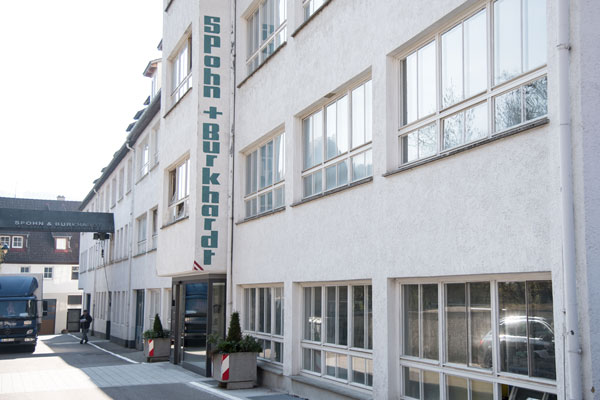The history of
Spohn + Burkhardt GmbH & Co.KG
History
ERROR: Content Element with uid "40002" and type "nstimeline" has no rendering definition!
The company was founded in 1920 in Blaubeuren by engineers Karl Spohn and David Burkhardt and it is still family-owned. Initially, the company repaired motors and switch gears with two technicians. During this period, the company began development of its own switchgears.
By 1930, Spohn + Burkhardt had 30 employees and had started production of larger devices, such as star-delta switches. Automatic switchgears were also incorporated into the production program.
Spohn + Burkhardt filed its first patent in 1942: the switch roller.
Spohn + Burkhardt began building complete control cabinets for cranes in 1948.
Due to the high demand for the company's products, the building in Blaubeuren was expanded in 1955 and renovated to provide more room for the employees.
Spohn + Burkhardt expanded the existing product portfolio of steel-grid resistors and wire wound resistors with cast iron resistors around 1960.
In 1964, construction of the second factory in nearby Schelklingen was completed. Initially, only metalworking took place there. The Schelklingen factory was successively expanded with construction of additional halls in order to relocate the control station and resistor departments and paint shop.
1965 – The NS0 joystick, a 2-axis joystick that could be operated with a single lever, unlike earlier control wheels was introduced. With the versatile modular system, the NS0 became an all-rounder, because it could be used for nearly every application.
One of the first Spohn + Burkhardt crane control stations was a combination of control unit and seat.
1984 – The product assortment was expanded with the development of various universal handles. Integration of a variety of different push-buttons and controls made it possible to control several functions with the joystick.
1999 – The ergonomically designed FSMMD control stand offered and continues to offer numerous functions that are very useful in multi-shift operation, in particular. It was now possible to adjust all functions electrically. It also had a "memory function" that made it possible to save specific settings.
2002 – The introduction of BUS systems assured simpler wiring with a clearer arrangement, because everything can be controlled via a plug connector.
2004 – With its narrow and wide handle half-shells, the UGA offers a wide variety of combination possibilities and functions. Therefore, it is now possible for the customer to equip their individual handle with a variety of components.
2006 – The FSRD is a universal control station for the hoist sector and industry sector. It has hydraulic and gas strut cushioning.
2010 – The FSRHDG was introduced to the market. This control stand is optimal for work in production. The high degree of freedom in adjustment possibilities and the outstanding ergonomics assure relaxed work without fatigue.
2012 – All-metal joystick manufactured with the highest precision, the JMS3. An aluminum base element is assembled with a positive-locking fit on the modular stainless steel and brass parts. Gentle and precise control is achieved with a solid brass gear and special oil-damped rotation dampers.
2014 – The ST4 was specially designed for wind and weather, snow and ice. It guarantees a tight seal and functionality even if the rubber gaiter is defective.
2015 – The HS2 was developed particularly for applications with all different bus systems. The non-wearing 3D hall sensor system enables a control system with up to 5 million switching cycles.
The FS innovation offers countless possibilities. Now customer-specific panels can be made in plastic with 3D printing.
2016 – The compact G50 handle expanded the control functions of a joystick with an additional axis. Rotating the spring-centered handle counterclockwise or clockwise generates a potentiometric output signal that can be used together with the direction rails integrated in the potentiometer for the various control tasks.
Today – Even if the functionality of our new 4-axis joystick or the multifunction armrest remain top priorities, the design of the products is becoming increasingly important.
Spohn + Burkhardt works constantly on its existing and future products for maximum functional, ergonomic and optical quality.






